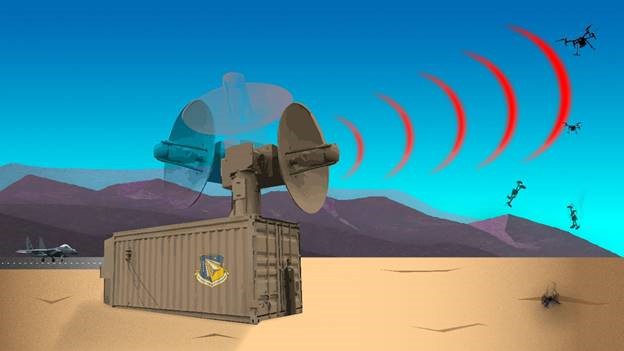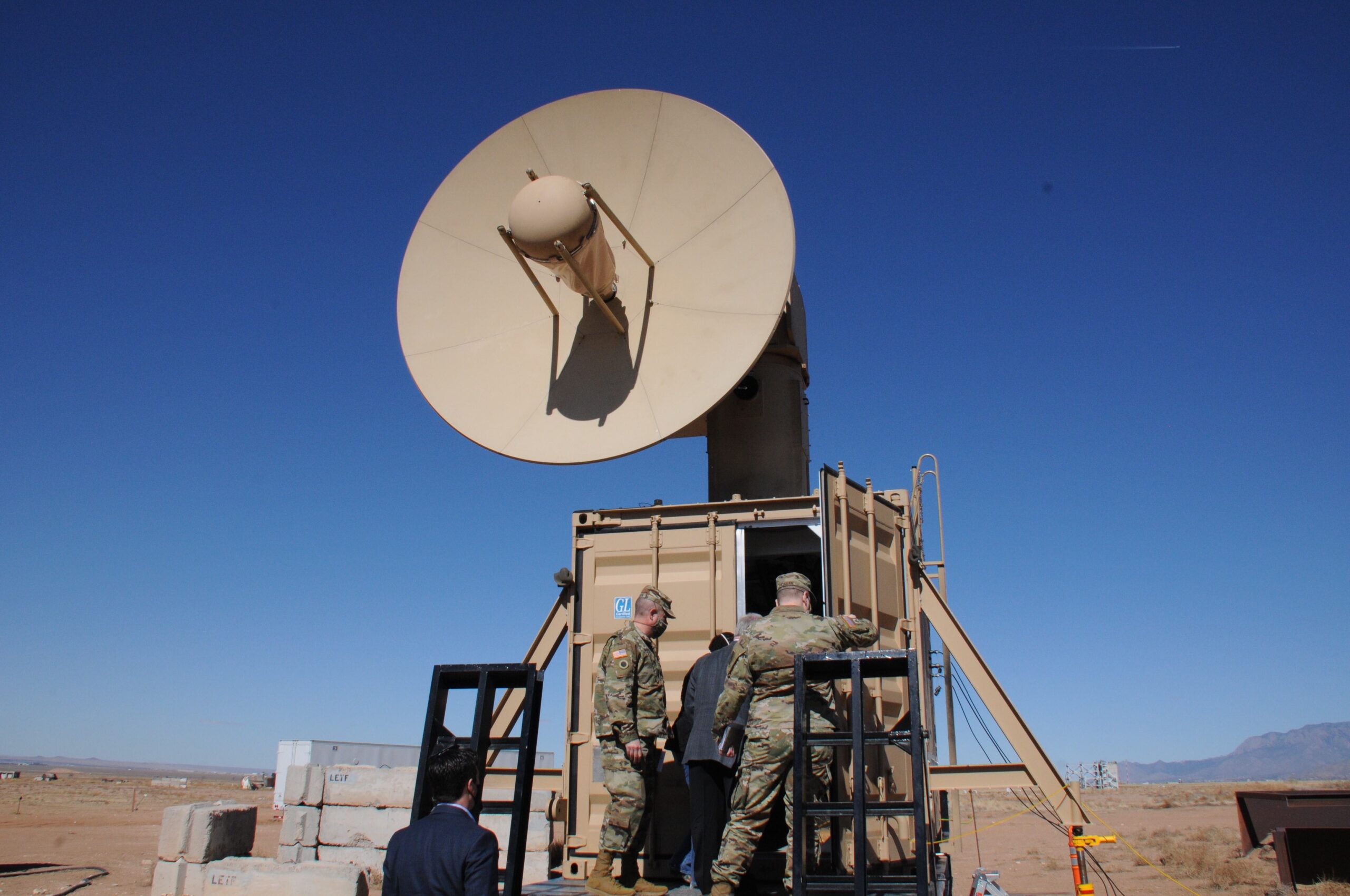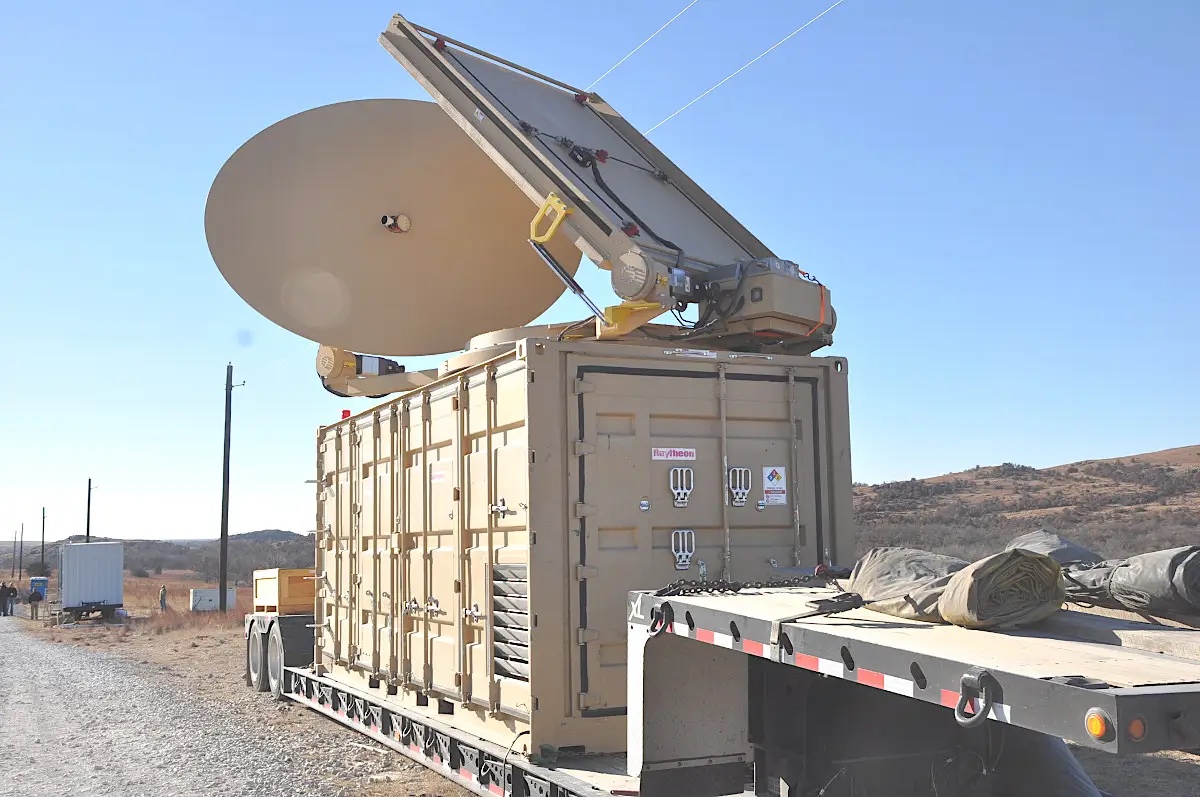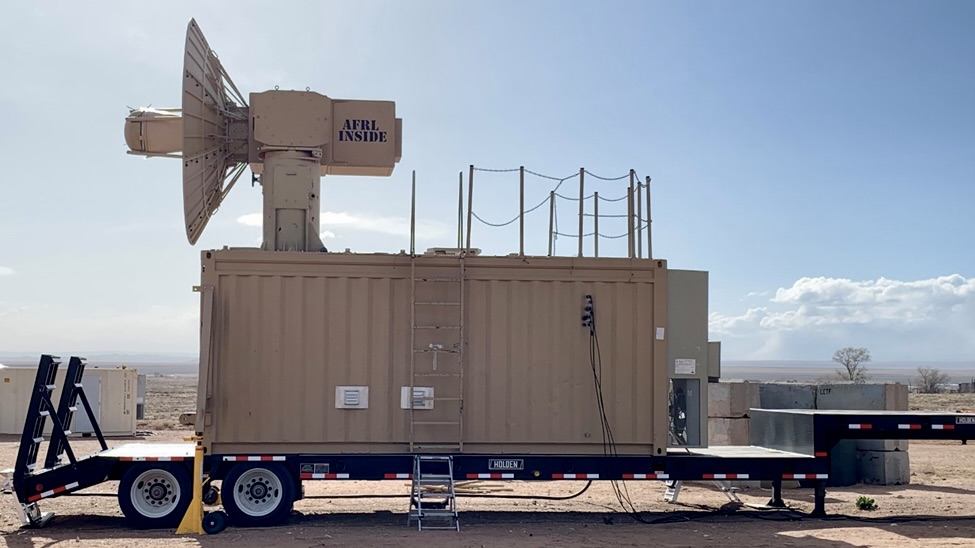The U.S. Air Force recently conducted a first-of-its-kind test of the Tactical High-power Operational Responder, also known as THOR. A high-power microwave counter-drone system, the containerized THOR is designed to engage multiple drones at short ranges in a point defense role. This comes as the threat of drones, particularly ones operating in large groups or fully-networked swarms, becomes increasingly urgent around the globe.
The Air Force Research Laboratory (AFRL) conducted the demonstration on April 5 at the Chestnut Test Site, Kirtland Air Force Base, New Mexico, according to a recent AFRL press release. During the demonstration, Capt. Eric Plummer, a test engineer with AFRL’s Directed Energy Directorate (DED), was responsible for aiming the THOR system as it “engaged a swarm of multiple targets,” the press release reads. This marks a significant moment for AFRL’s DED, which has been field-testing THOR for several years now, with the press release describing the demonstration as “the first test of this scale in AFRL history.” At present, we do not know exactly how many drones or what kind(s) were involved in the demonstration. The War Zone has reached out to AFRL for more details on this.

“The THOR team flew numerous drones at the THOR system to simulate a real-world swarm attack,” notes Adrian Lucero, THOR program manager at AFRL’s DED. “THOR has never been tested against these types of drones before, but this did not stop the system from dropping the targets out of the sky with its non-kinetic, speed-of-light High-Power Microwave, or HPM pulses.”
As Lucero indicates, THOR uses high-power microwaves to essentially fry, disable, or disrupt electronic systems on a target. Significantly, THOR can be used against multiple targets at once, making it a potentially invaluable weapon for defense against drone swarms where other close-in defenses — everything from gun systems to lasers — may struggle.
Of course, as we’ve noted in the past, an HPM system’s power levels and how it focuses its beam have impacts on its range and ability to engage multiple threats at once. Precise details regarding THOR’s range are not immediately clear, beyond its engagement of targets at short ranges. We have reached out to AFRL for clarification.
It’s also worth noting that while countering drones are the main objective at this time, HPM systems can also potentially be used against low-flying cruise missiles and even land/surface targets.

THOR can be set up within three hours and operates using ground power from a ‘wall plug.’ It also features a “user-friendly interface,” according to AFRL, designed to require minimal user training. The system stows completely in a 20 foot transport container, which AFRL highlights can easily be transported via a C-130 Hercules cargo aircraft. You can read more about the advantages of highly transportable electronic warfare containers here.
The overall cost of developing the technology supporting THOR amounts to around $18 million dollars, AFRL notes. The THOR program represents a collaboration between AFRL, BAE Systems, Leidos, and Verus Research, an engineering firm based in Albuquerque. THOR made its debut in 2019, after a quick 18-month development cycle.
“THOR was extremely efficient with a near continuous firing of the system during the swarm engagement,” said Capt. Tylar Hanson, THOR deputy program manager, of the recent demonstration. “It is an early demonstrator, and we are confident we can take this same technology and make it more effective to protect our personnel around the world.”

The road to the recent successful test has not been smooth sailing for AFRL, with notable technological problems during THOR’s early development. As Will Roper, assistant secretary of the Air Force for Acquisition, Technology, and Logistics told a gathering at the Center for Strategic and International Studies think tank in March 2019, THOR was then unable to “hit targets that mattered for mission.” In late 2020, a prototype THOR system was tested “in a real-world setting” in Africa, at which point the counter-drone system worked “remarkably well,” Richard Joseph, the Air Force’s chief scientist, said at the time. Other modifications to THOR have been implemented since then. It’s unclear when exactly THOR might see widespread use within the Air Force.
Of course, the Air Force isn’t the only branch of the U.S. military interested in THOR. The U.S. Army officially announced it was contributing financially to the program in early 2021, with THOR being used as part of an Indirect Fire Protection Capability-High Power Microwave (IFPC-HPM) prototype system that the service plans to field by Fiscal Year 2024.

Initial promise in THOR’s development led the Air Force to begin efforts for a spin-off program in mid 2021. In early 2022, AFRL awarded Leidos a $26 million contract for the development of the counter-UAS ‘Mjölnir’ weapon. Mjölnir builds on technology demonstrated in the THOR program, with improvements by AFRL. An initial prototype is expected to be delivered this year.
The Air Force has been experimenting with various anti-drone directed energy weapons, including lasers, in recent years to combat the threats posed by small unmanned aircraft. These have included other high-power microwave counter-drone systems such as Raytheon’s Phaser, and the Counter-Electronic High-Power Microwave Extended-Range Air Base Air Defense, also known as CHIMERA.

As noted above, other branches of the U.S. military are looking to high-powered microwaves to target drones and drone swarms, too. Electronic warfare capabilities, missiles and guns, and even other drones are also used for counter-drone purposes, as well, as the U.S. military has had to take the issue of anti-drone capabilities more seriously.
Epirus’s Leonidas system is also of particular interest and work is being done to integrate the hardware onto a Stryker armored fighting vehicle, which could be a big win for protecting units on the go from drones. The Army, in general, sees Leonidas as a promising system, and a contract worth tens of millions was awarded to Epirus by the service to further evolve the system in January.

The Navy is also working to bring HPM capabilities to its vessels. While smaller drones would be very hard pressed to sink a warship, they can damage or destroy critical sensors and disable vessels causing a ‘mission kill’ in which the ship survives. This means the ship can no longer perform its mission, or that its effectiveness is degraded to a state in which it is vulnerable to further attacks. As we pointed out years ago, a swarm attack on a vessel would be very hard to overcome with existing close-in defensive systems that are limited to how many targets they can engage at once, and in terms of magazine capacity.
Indeed, the threat from drones comes in all shapes and sizes. Weaponized commercial designs are increasingly being used by terrorist groups, organized criminal organizations, and other non-state actors, as well as major militaries. While defending against drone attacks is a hard enough prospect, this becomes all the more difficult when groups of unmanned small aircraft are networked together in weaponized swarms.
As The War Zone has highlighted in the past, networked swarms of drones would likely play a key role in a potential future conflict with China, possibly over Taiwan. This is where high-power microwave counter-drone systems, such as THOR, could become particularly useful, with their ability to knock-out large groups and even swarms of drones rapidly with broad disruptive beams. This differs from laser applications which are more limited in their multi-target engagement capabilities. Kinetic solutions, such as missiles and guns, lack magazine depth, which is not an issue with directed energy solutions. Directed energy weapons are also far less expensive on a ‘cost per shot’ basis.
Of course, high-power microwave counter-drone systems are still likely to be integrated within layered defenses, and are by no means a silver bullet. But, at this time, beyond traditional electronic warfare that is useless against many drones, high-power microwave systems look set to become the best way to drop multiple drones fast at close distances.
With the use of drones by foreign adversaries on the rise, the need to defend against them remains high. This includes protecting troops in the field, ships at sea, and even flightlines at home. The latest THOR test represents an important step forward in advancing the Air Force’s ability to counter drones, and drone swarms, in the future.
Contact the author: oliver@thewarzone.com
